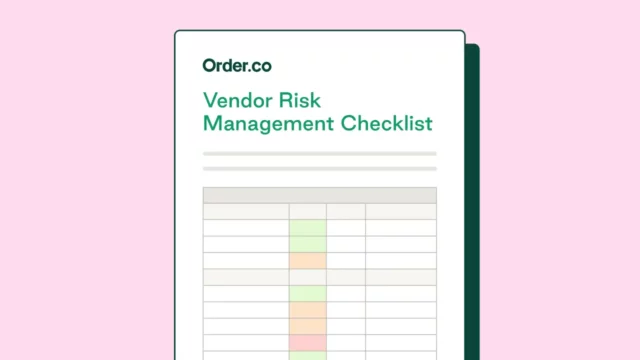Why Vendor‐Locked Virtual Cards Are Your Business’s Best Defense Against Payment Fraud

Why Vendor‐Locked Virtual Cards Are Your Business’s Best Defense Against Payment Fraud
The costliest risk to your business may be hiding in plain sight: payment fraud. In 2024, 79% of organizations were victims of payment fraud attacks or attempts, according to the 2025 AFP Payments Fraud and Control Survey.
Compounding the challenge is the rise of card-not-present (CNP) fraud, which accounts for 74% of all payment card fraud losses. As fraud attempts grow more sophisticated, shared corporate cards often lack the context-specific controls required to prevent unauthorized purchases.
However, vendor-locked virtual cards present a more secure alternative. Read on to explore why vendor-locked cards offer a necessary upgrade and how they outperform standard options.
Download the free tool: Vendor Risk Management Checklist
What is a vendor‐locked virtual card?
Vendor-locked virtual cards are designed specifically to bolster payment security. While standard virtual cards and physical corporate cards can be used anywhere, a vendor‐locked virtual card is tied exclusively to one approved vendor. Once a card gets assigned to a specific vendor, any attempts to use the card with other merchants are automatically declined, and businesses receive a notification that an unauthorized vendor attempted to charge the card.
Businesses can issue vendor-locked cards only after approval, ensuring that each payment is intentional and tied to a legitimate transaction. Once “locked” to a specific vendor and spending limit, these virtual cards proactively block misuse and eliminate the risk of funds being used by fraudsters.
The benefits of vendor-locked cards extend beyond security. Vendor-locked virtual cards, like the ones offered by Order.co, give businesses the flexibility to pay for purchases outside of their standard product catalog, while still consolidating billing and reporting information. This capability simplifies reconciliation and delivers real-time visibility into how your team spends across locations, teams, and product categories. With these controls embedded at the point of purchase, businesses can both strengthen fraud defenses and simplify day-to-day financial management.
How vendor-locked virtual cards prevent real-world fraud attempts
Payment fraud can take many forms, from subtle misuse to sophisticated scams. Here are some of the most common scenarios where vendor-locked cards protect your businesses by proactively blocking unauthorized charges:
- Inbox phishing and BEC (Business Email Compromise): Fraudsters can intercept a virtual card number sent to a vendor. Without a lock, it can be abused; with a vendor lock, the charge is declined automatically.
- Internal misuse or rogue spend: Employees using cards to order from unapproved vendors are stopped at the point of purchase.
- Recurring or forgotten charges: A non‐locked virtual card tied to a SaaS subscription can keep billing indefinitely. Vendor lock, combined with expiration controls, ensures renewals must be re‐approved.
- Card number leaks in vendor systems: If a vendor’s database is compromised, stolen card details are useless with any other merchant.
- Fraudulent resellers or lookalike vendors: Fraudsters sometimes pose as legitimate suppliers. A vendor lock ensures the card only works with the exact pre-approved vendor, blocking payments to imposters.
In each case, leveraging vendor-locked cards makes it easy for your business to strengthen financial security. J.P. Morgan data even suggests virtual card solutions see nearly 0% fraud compared to other payment options. The result is a payment option that reduces risk, increases spend control, and delivers measurable value across your business.
Why standard virtual cards are not enough
Regular virtual cards that can be used to pay any vendor are more secure than physical cards, but still leave significant gaps when it comes to fraud protection and spend control. Since they lack vendor-specific restrictions, these cards:
- Can be used at unauthorized vendors if card details leak, exposing your business to financial loss.
- Don’t protect against cross‐vendor fraud, making charges with unauthorized merchants difficult to detect.
- Have no direct link to POs or vendor approvals, increasing the risk of unapproved spend slipping through.
By contrast, vendor‐locked cards bind every transaction to a pre-approved vendor. Even if a card’s information is compromised, it cannot be used elsewhere. With these controls embedded at the point of payment, your business can reduce fraud risk without creating approval bottlenecks.
Fortify your business against payment fraud with Order.co’s virtual cards
As payment fraud grows more sophisticated, vendor-locked virtual cards are essential to protect your business. Leveraging Order.co’s virtual cards and procure-to-pay capabilities, you can:
- Gain 20% more float per transaction: Order.co offers more float than traditional corporate cards or any other P2P platform on the market.
- Centralize procurement: Pay for everything your business needs, like consumables, office and cleaning supplies, services, subscriptions, and more in one place.
- Reduce accounting costs: Invoice consolidation and seamless AP software integrations save $12-25 per invoice.
- Improve vendor relationships: Payments are predictable and accurate, helping to reinforce trust with vendors.
- Enhance operational efficiency: With fewer sourcing, ordering, and AP tasks, teams can focus on higher-value work.
- Avoid costly chargebacks: Chargebacks often range from $15 to $100 per case, which can add up over time.
Ready to learn more about how Order.co virtual cards can help your business enhance payment security and drive operational efficiency? Request a demo today.
Get started
Schedule a demo to see how Order.co can simplify buying for your business.
"*" indicates required fields



